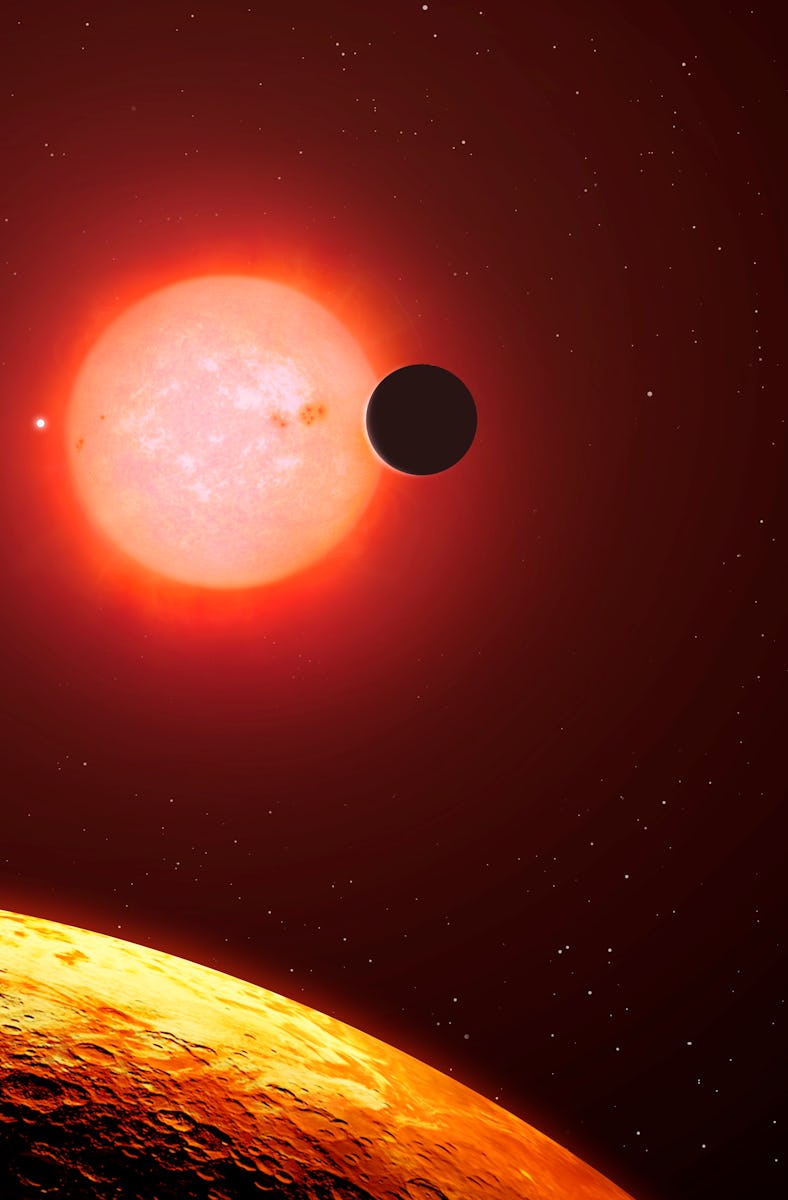New Details About TRAPPIST-1 Could Flip Our Search For Alien Life Upside Down
Recent JWST observations reveal there's no atmosphere, or at best a very thin one, on the second exoplanet in the TRAPPIST-1 system.

A second exoplanet in the TRAPPIST-1 system turns out to have no atmosphere, according to recent data from the James Webb Space Telescope (JWST), and that could be bad news for the search for life in the once very promising star system.
Using JWST’s Mid-Infrared Instrument, or MIRI, a team of astronomers recently took the temperature of TRAPPIST-1c, the second-closest planet orbiting red dwarf star TRAPPIST-1c. The planet orbits so close to its star that it’s tidally locked, meaning the same side of the planet always faces the star. And TRAPPIST-1c’s dayside is much hotter than it should be if air currents were moving heat around the planet. That suggests there’s little to no atmosphere on this rocky little exoplanet.
“These results motivate observations of cooler planets, which may be more likely to retain atmospheres,” Astronomer Sebastian Zieba of the Max Planck Institute for Astronomy and his colleagues write in their recent paper in the journal Nature. However, the results may also have discouraging implications for the chances of finding atmospheres on the three worlds in TRAPPIST-1’s habitable zone: TRAPPIST 1e, 1f, and 1g.
Is there air on any of the TRAPPIST-1 exoplanets?
This image shows the star and six of the planets as they would appear from the vantage point of the fifth outermost planet, Trappist-1f. All of the planets and the Sun are to scale. One of the worlds is seen transiting in front of the star.
Most of the Earthlike (meaning small worlds made of rock instead of enormous gas giants) exoplanets that astronomers have discovered in the habitable zones of distant stars orbit small, cool stars called red dwarfs. That’s because an Earthlike world passing between the Sun and a distant telescope wouldn’t block enough light to be noticeable, but against the backdrop of a smaller, dimmer red dwarf, our world would be easy to spot. So astronomers are very interested in using JWST to learn more about these worlds, starting with what kinds of atmospheres they have.
But so far, the results haven’t been encouraging. TRAPPIST-1b, the innermost world in the TRAPPIST-1 system, seems to be a bare rock with no atmosphere at all. That’s not terribly surprising, given that 1b orbits TRAPPIST-1 so closely that it makes a full lap around the star every 36 hours. Zieba and his colleagues used JWST’s MIRI instrument to measure the temperature on the dayside of TRAPPIST-1c, the second planet from the star.
To do this, the astronomers watched for what’s called a secondary eclipse: the moment when an exoplanet starts to disappear behind the far side of its star and the moment it begins to reappear again. Those brief moments are the only time when a tidally-locked exoplanet’s dayside is actually facing us. It turned out that the average temperature on the permanently daylit side of TRAPPIST-1c is around 224 degrees Fahrenheit, which is somewhere between the average temperatures of Mercury and Venus.
This NASA illustration shows the habitable zones of TRAPPIST-1 and our Sun.
According to computer simulations, TRAPPIST-1c’s dayside couldn’t stay that hot if the planet had an atmosphere thick enough to move heat around. Atmospheres are great at moving energy from hot areas to cold areas; that drives our weather patterns here on Earth. On an exoplanet like TRAPPIST-1c, it should move heat from the hot dayside to the cooler nightside. In that case, the dayside would be a lot cooler than it is, and the nightside would be warmer.
If Zieba and his colleagues are correct, the bad news may not stop at “there’s no air on TRAPPIST-1c.” After all, we never expected TRAPPIST-1c to be habitable anyway, it’s just too close to the star. It would be like trying to live on Mercury. However, the lack of an atmosphere may suggest that TRAPPIST-1c formed without a good supply of what are called volatile elements, which include things like oxygen, carbon, nitrogen, and hydrogen — coincidentally, some of the most essential elements for life and habitability.
“If all planets in the system formed in the same way, this would indicate a limited reservoir of volatiles for the potentially habitable planets in the system,” write Zieba and his colleagues.
But the only way to find out is to look closely at the three planets in TRAPPIST-1b’s habitable zone. Cornell University planetary scientist Nikole Lewis and her colleagues plan to aim JWST at TRAPPIST-e, the innermost of the potentially habitable worlds, this summer.
This article was originally published on